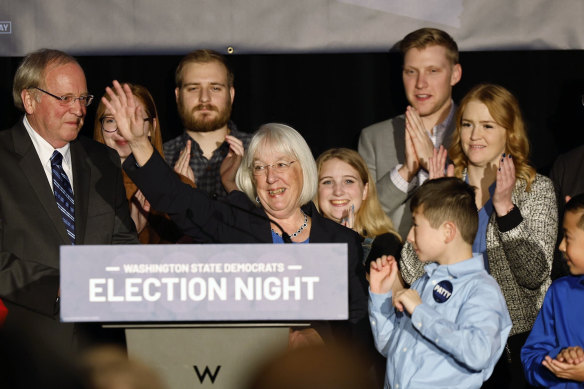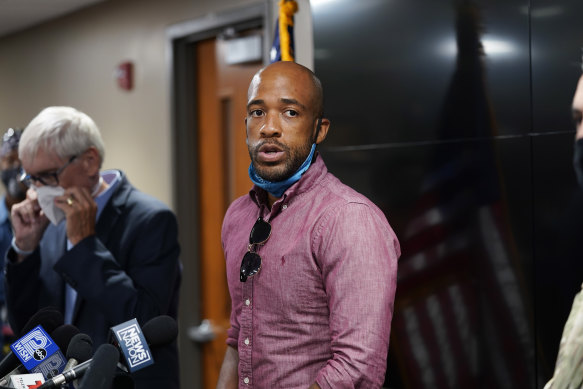
Senator Patty Murray, a Democrat, had consistently won reelection by healthy margins in her three decades representing Washington state. This year seemed no different: By midsummer, polls showed her cruising to victory over a Republican newcomer, Tiffany Smiley, by as much as 20 percentage points.
So when a survey in late September by the Republican-leaning Trafalgar Group showed Murray clinging to a lead of just 2 points, it seemed like an aberration. But in October, two more Republican-leaning polls put Murray barely ahead, and a third said the race was a dead heat.
Skewed red-wave surveys fed home-team boosterism among right-wing news outlets and benefited from cheerleading by former President Donald J. Trump.Credit:AP
As the red and blue trend lines of the closely watched RealClearPolitics average for the contest drew closer together, news organisations reported that Murray was suddenly in a fight for her political survival. Warning lights flashed in Democratic war rooms. If Murray was in trouble, no Democrat was safe.
Murray’s own polling showed her with a comfortable lead, and a nonprofit regional news site, using an established local pollster, had her up by 13. Unwilling to take chances, however, she went on the defensive, scuttling her practice of lavishing some of her war chest — she amassed $US20 million — on more vulnerable Democratic candidates elsewhere. Instead, she reaped financial help from the party’s national Senate committee and super political action committees — resources that would, as a result, be unavailable to other Democrats.
A similar sequence of events played out in battlegrounds nationwide. Surveys showing strength for Republicans, often from the same partisan pollsters, set off Democratic alarm bells in Pennsylvania, New Hampshire and Colorado. Coupled with the political factors already favouring Republicans — including inflation and President Joe Biden’s unpopularity — the skewed polls helped feed what quickly became an inescapable political narrative: A Republican wave election was about to hit the country with hurricane force.
Democrats in each of those states went on to win their Senate races. Murray clobbered Smiley by nearly 15 points.
Not for the first time, a warped understanding of the contours of a national election had come to dominate the views of political operatives, donors, journalists and, in some cases, the candidates themselves.
The misleading polls of 2022 did not just needlessly spook some worried candidates into spending more money than they may have needed to on their own races. They also led some candidates — in both parties — who had a fighting chance of winning to lose out on money that could have made it possible for them to do so, as those controlling the purse strings believed polls that inaccurately indicated they had no chance at all.
In the election’s immediate aftermath, the polling failures appeared to be in keeping with misfires in 2016 and 2020, when the strength of Donald Trump’s support was widely underestimated, and with the continuing struggles of an industry that arose with the corded home telephone to adapt to the mass migration to cellphones and text messaging. Indeed, some of the same Republican-leaning pollsters who erred in 2022 had built credibility with their contrarian, but accurate, polling triumphs in recent elections.
But a New York Times review of the forces driving the narrative of a coming red wave, and of that narrative’s impact, found new factors at play.
Traditional nonpartisan pollsters, after years of trial and error and tweaking of their methodologies, produced polls that largely reflected reality. But they also conducted fewer polls than in the past.
That paucity allowed their accurate findings to be overwhelmed by an onrush of partisan polls in key states that more readily suited the needs of the sprawling and voracious political content machine — one sustained by ratings and clicks, and famished for fresh data and compelling narratives.
The skewed red wave surveys polluted polling averages, which are relied upon by campaigns, donors, voters and the news media. It fed the home team boosterism of an expanding array of right-wing media outlets — from Steve Bannon’s War Room podcast and The Charlie Kirk Show to Fox News and its top-rated prime-time lineup. And it spilled over into coverage by mainstream news organisations, including the Times, that amplified the alarms being sounded about potential Democratic doom.
The virtual “bazaar of polls,” as a top Republican strategist called it, was largely kept humming by right-leaning pollsters using opaque methodology, in some cases relying on financial support from hyperpartisan groups and benefiting from vociferous cheerleading by Trump.
Yet questionable polls were not only put out by Republicans. The executive director of one of the more prominent Democratic-leaning firms that promoted polls this cycle, Data for Progress, was boasting about placing bets on election outcomes, raising at least the appearance of a conflict of interest.
Other pollsters lacked experience, like two high school juniors in Pennsylvania who started Patriot Polling and quickly found their surveys included on the statistical analysis website FiveThirtyEight — as did another high school concern based at Phillips Academy in Andover, Massachusetts.
‘Somebody turned a switch’
Shaping perceptions across the ideological spectrum, the steady flow of data predicting a red wave prompted real-world decision-making that members of both parties now say could have tilted the balance of power in Congress.
Won by near 15 percentage points: Democratic Senator Patty Murray.Credit:AP
“These frothy polls had a substantial, distorting impact on how people spent money — on campaign strategy, and on people’s expectations going into the election,” said Steven J. Law, the CEO of the Republicans’ Senate Leadership Fund, which poured $US280 million ($417 million) into the midterms. Its own private polling showed no red wave at all.
There were ample reasons to expect a strong 2022 for Republicans. A president’s party tends to lose congressional seats in midterms. Soaring inflation and Biden’s languishing approval ratings only added to GOP hopes.
But the Supreme Court’s overturning of Roe v Wade and the stolen election fantasies of right-wing Republican candidates blew unexpected wind in Democrats’ sails.
Summertime polls indicated surprising Democratic strength. “Red Wave? Hard to see one now,” Simon Rosenberg, a former adviser to the Democratic Congressional Campaign Committee, headlined a June 21 post on the blog of his liberal advocacy group, the New Democrat Network.
Later, when a cascade of Republican-skewing polls pointed to a major reversal, Rosenberg said in an interview, “it was as if somebody turned a switch on.”
In New Hampshire, nonpartisan polls by The Boston Globe and the University of Massachusetts, Lowell, showed Senator Maggie Hassan, a Democrat, holding a comfortable 8- or 10-point lead over her Republican opponent, Don Bolduc.
But Trafalgar and InsiderAdvantage had them in a neck-and-neck race. (She won by 9 points.)
In Pennsylvania, the same two firms gave Lieutenant Governor John Fetterman, the Democratic Senate candidate, a smaller lead over Dr. Mehmet Oz, and eventually showed Fetterman trailing — a departure from nonpartisan polls like Marist and Fox News. (He won by nearly 5 points.)
Worried that the GOP-inflected polls were wrong and were liable to persuade Democratic grassroots activists to give up rather than go out and knock on doors, Rosenberg used his podcast and his Twitter account to tell Democrats that their chances were better than they realised.
His bullishness earned him ribbing and ridicule. In an August article calling him “the most optimistic Dem online,” Politico noted that at times it seemed that Rosenberg was pushing his relentlessly rosy view at “profound reputational risk”.
By the fall, perceptions of a red wave were starting to affect strategies, pushing money toward mistakenly perceived trouble spots. Insiders in both parties, mindful of past errors, began to doubt their own internal polls.
“We were limited in how aggressive we could get, because there was a feeling we were about to get absolutely smoked,” said Tim Persico, the executive director of the Democratic Congressional Campaign Committee, which oversees House races. “It comes down to what level of risk you are willing to take if your data is standing alone in a world where everyone else is telling you the opposite.”
A case in point was Wisconsin.
The state Democratic chair, Ben Wikler, was seeing private internal polling that showed his party’s Senate candidate, Lieutenant Governor Mandela Barnes, within 1 or 2 points of Senator Ron Johnson, a right-wing Republican and purveyor of misinformation.
Closer to victory than many polls showed. Wisconsin Lieutenant Governor Mandela Barnes.Credit:AP
But red-hued polling began to show Johnson pulling away. Data for Progress put the incumbent up by 5; Patriot Polling, run by the Pennsylvania high school students, had his lead at 8. By early October, RealClearPolitics was projecting that Johnson could win by as much as 7 points.
Some major Democratic donors concluded that Barnes’ race was a lost cause, Wikler said, and that they should redirect their money where it could still help. “I had donors calling me to say they weren’t giving to the Senate race,” he said.
Barnes lost by 1 point. While Democrats in the state debate whether more money would have made the difference — Barnes out-raised Johnson — Wikler pointed to the walloping Barnes took from outside groups supporting Johnson, which outspent those supporting Barnes by $US26.4 million.
“If you were going to allocate resources for maximum impact,” Wikler said ruefully, “you wouldn’t let Mandela Barnes be outspent by $US26 million on independent expenditures and lose by 26,000 votes.”
Polls heralding GOP victories hurt Republicans, too.
Law, of the Senate Leadership Fund, relied on private polls that suggested Republican candidates needed to fight for every vote, but he watched in distress as many took victory for granted.
“All of these effervescent polls and giddiness about a big red wave,” he said, “led some Republican candidates to believe all they had to do was play to late-night cable and the hard-core base, instead of reaching out to independent voters who decided the election.”
His biggest frustration came in the Southwest. His internal polling showed that the GOP’s Senate candidate in Arizona, Blake Masters, faced long odds, and that the Republican hopeful in Nevada, Adam Laxalt, could win with enough financial support.
Law pulled money out of Arizona. Still, as he poured cash into Nevada, moneyed allies continued to prioritise Masters, apparently trusting public polls suggesting that Laxalt had a solid advantage. Laxalt lost by 8000 votes.
Polling that lifted ratings
Polls of political races weren’t just being used in 2022 to determine the state of play in those campaigns. Other agendas were also at work.
Surveys creating the misimpression of a red wave proved particularly useful to right-wing media outlets. Among their audience, evidence pointing to Republican victories and Democratic defeats was in high demand — particularly on Fox News.
The network’s own polling unit, respected throughout the news industry for its nonpartisanship and transparency, was not detecting a Republican wave. But in September, Sean Hannity’s prime-time show began showcasing pollsters Robert Cahaly of Trafalgar and Matt Towery of InsiderAdvantage, who predicted that Republicans would take the contests in Pennsylvania, Arizona and Georgia, among other places.
Unmentioned was that the Fox News Poll, amply covered in the network’s straight-news programming, showed all those races leaning Democratic.
Towery declined to be interviewed but issued a brief statement acknowledging that getting it wrong “happens in this business” and noting that RealClearPolitics ranked his firm as the second-most accurate national pollster for the 2016, 2018 and 2020 cycles. Cahaly, ranked fifth in those cycles, asked to be sent written questions but did not respond to them. In a November interview with New York Magazine, he attributed his polling misses to weak Republican campaigns.
Hannity, on his program, noted that he had emphasised to his audience the tight margins in competitive races. Fox News did not comment on its hosts’ use of polling.
But history points to a likely explanation: ratings, which determine advertising revenue and have tended to rise and fall with Republicans’ prospects.
“The culture of programming does not take kindly to narratives of ‘we’re behind’ or ‘we’re losing,’” said Jason Damata, the founder and CEO of Fabric Media, a media and advertising consultancy. “Fox has a profound understanding of what’s going to keep audiences coming back and being engaged.”
‘Red Wave’ Trickles Ashore
By late October, the Republican wave had surged into a “red tsunami,” a phrase uttered nearly 4000 times that month on radio, television and podcasts, according to media tracking firm Critical Mention — a more than tenfold increase from September. References to a red tsunami nearly doubled again in the first eight days of November.
Watching it all unfold from his offices in northwest Washington, Tom Bonier, the CEO of TargetSmart, a Democratic data clearinghouse, worried about the damage being done by overly Republican-leaning polls.
He was certain Democrats were on track to have a surprisingly good year, as liberal and moderate voters alike protested the Supreme Court’s striking down of a federal right to abortion and rejected as too extreme many Republican candidates who continued to deny the results of the 2020 presidential race.
But Bonier feared “the extent to which perception drives reality,” he said in a post-election interview.
Perceptions of a looming red wave bred stories that sought to explain it, theorising that voters cared more about crime and the price of gas than, say, abortion.
Bonier saw a devious logic. He said he suspected that GOP-aligned firms were pumping out polls to help Republicans regain momentum that had shifted toward the Democrats.
“That was the point of this red wave polling surge,” he said.
As Bonier and Rosenberg pleaded with Democrats not to let unreliable polls dissuade them from donating to campaigns or knocking on doors, they repeatedly ran into scepticism from people citing the averages on RealClearPolitics and FiveThirtyEight.
But the averages were being affected by a widening imbalance between a dwindling number of reliable, reputable nonpartisan polls, and a proliferation of questionable surveys.
FiveThirtyEight itself flagged the imbalance: “Compared with past cycles, polls in 2022 are more likely to be sponsored or associated with partisan sources,” an article on the site said in October. “This is a problem because partisan polls tend to be more inaccurate.”
The imbalance arose in part from an industrywide challenge. Traditional surveys using over-the-phone interviews, with human beings asking the questions, have grown astronomically more expensive as Americans become harder to reach and less willing to sit through time-consuming questionnaires with strangers.
Reputable pollsters like Gallup and Pew have phased out “horse race” polling entirely; others have cut back. Quinnipiac University conducted just a few statewide surveys in the final stretch this year. “Frankly, cost is an issue,” said Doug Schwartz, Quinnipiac’s polling director.
At the same time, it has never been easier or cheaper to conduct lesser-quality polls using internet questionnaires or automated phone services.
One newcomer to the industry that illustrated the low barrier to entry was Patriot Polling, incorporated in September in suburban Philadelphia by two high school juniors.
The pair — Lucca Ruggieri, 17, who identifies as a Republican, and Arhan Kaul, 16, who is more interested in data science than politics — met at a program for future leaders, joked about how terrible polling had been in recent elections and decided to take a stab at it themselves. At worst, they figured, they would bolster their college applications.
A statistics teacher and local Republicans and Democrats gave them pointers. Ruggieri’s father agreed to pay for the automated phone calls, at about $US2500 a poll — compared with tens of thousands of dollars for polls relying on live interviews.
The first survey they published was among the first in the nation to give Oz a lead over Fetterman. It caught the attention of FiveThirtyEight, which, after inquiring about their methodology, began to publish their results.
Ruggieri was bowled over. “I wouldn’t think they would look at high schoolers,” he said.
When critics questioned FiveThirtyEight for taking the youngsters’ polls seriously, an election analyst at the site called the critique “ageist,” saying “students can do awesome work.” Indeed, Patriot’s poll for the New York governor’s race roughly reflected the outcome, and its survey in the Arizona Senate race came closer to the final result than those of Trafalgar and InsiderAdvantage.
To Rosenberg and Bonier, teenagers weren’t responsible for the false red wave narrative — it was partisan pollsters, who flooded the market with outlier results and were abetted by the keepers of the polling averages.
“We can’t trust the data on RealClearPolitics or FiveThirtyEight any longer,” Rosenberg complained on MSNBC in late October, “because it’s essentially Republican propaganda.”
This article originally appeared in The New York Times.
Get a note directly from our foreign correspondents on what’s making headlines around the world. Sign up for the weekly What in the World newsletter here.
Most Viewed in World
From our partners
Source: Read Full Article


